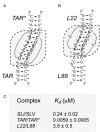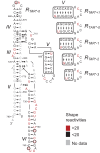Rational engineering of the Neurospora VS ribozyme to allow substrate recognition via different kissing-loop interactions
- PMID: 27166370
- PMCID: PMC5001590
- DOI: 10.1093/nar/gkw401
Rational engineering of the Neurospora VS ribozyme to allow substrate recognition via different kissing-loop interactions
Abstract
The Neurospora VS ribozyme is a catalytic RNA that has the unique ability to specifically recognize and cleave a stem-loop substrate through formation of a highly stable kissing-loop interaction (KLI). In order to explore the engineering potential of the VS ribozyme to cleave alternate substrates, we substituted the wild-type KLI by other known KLIs using an innovative engineering method that combines rational and combinatorial approaches. A bioinformatic search of the protein data bank was initially performed to identify KLIs that are structurally similar to the one found in the VS ribozyme. Next, substrate/ribozyme (S/R) pairs that incorporate these alternative KLIs were kinetically and structurally characterized. Interestingly, several of the resulting S/R pairs allowed substrate cleavage with substantial catalytic efficiency, although with reduced activity compared to the reference S/R pair. Overall, this study describes an innovative approach for RNA engineering and establishes that the KLI of the trans VS ribozyme can be adapted to cleave other folded RNA substrates.
© The Author(s) 2016. Published by Oxford University Press on behalf of Nucleic Acids Research.
Figures





Similar articles
-
Insights into RNA structure and dynamics from recent NMR and X-ray studies of the Neurospora Varkud satellite ribozyme.Wiley Interdiscip Rev RNA. 2017 Sep;8(5):e1421. doi: 10.1002/wrna.1421. Epub 2017 Apr 6. Wiley Interdiscip Rev RNA. 2017. PMID: 28382748 Free PMC article. Review.
-
A remarkably stable kissing-loop interaction defines substrate recognition by the Neurospora Varkud Satellite ribozyme.RNA. 2014 Sep;20(9):1451-64. doi: 10.1261/rna.046144.114. Epub 2014 Jul 22. RNA. 2014. PMID: 25051972 Free PMC article.
-
Rearrangement of substrate secondary structure facilitates binding to the Neurospora VS ribozyme.J Mol Biol. 2002 Dec 13;324(5):903-15. doi: 10.1016/s0022-2836(02)01151-8. J Mol Biol. 2002. PMID: 12470948
-
Nuclear magnetic resonance structure of the Varkud satellite ribozyme stem-loop V RNA and magnesium-ion binding from chemical-shift mapping.Biochemistry. 2005 Mar 22;44(11):4157-70. doi: 10.1021/bi047963l. Biochemistry. 2005. PMID: 15766243
-
The Neurospora Varkud satellite ribozyme.Biochem Soc Trans. 2002 Nov;30(Pt 6):1122-6. doi: 10.1042/bst0301122. Biochem Soc Trans. 2002. PMID: 12440987 Review.
Cited by
-
Substrate promiscuity of Dicer toward precursors of the let-7 family and their 3'-end modifications.Cell Mol Life Sci. 2024 Jan 23;81(1):53. doi: 10.1007/s00018-023-05090-2. Cell Mol Life Sci. 2024. PMID: 38261114 Free PMC article.
-
A multi-axial RNA joint with a large range of motion promotes sampling of an active ribozyme conformation.Nucleic Acids Res. 2019 Apr 23;47(7):3739-3751. doi: 10.1093/nar/gkz098. Nucleic Acids Res. 2019. PMID: 30993347 Free PMC article.
-
Aptamers, Riboswitches, and Ribozymes in S. cerevisiae Synthetic Biology.Life (Basel). 2021 Mar 17;11(3):248. doi: 10.3390/life11030248. Life (Basel). 2021. PMID: 33802772 Free PMC article. Review.
-
Insights into RNA structure and dynamics from recent NMR and X-ray studies of the Neurospora Varkud satellite ribozyme.Wiley Interdiscip Rev RNA. 2017 Sep;8(5):e1421. doi: 10.1002/wrna.1421. Epub 2017 Apr 6. Wiley Interdiscip Rev RNA. 2017. PMID: 28382748 Free PMC article. Review.
-
Self-cleaving ribozymes: substrate specificity and synthetic biology applications.RSC Chem Biol. 2021 Jul 2;2(5):1370-1383. doi: 10.1039/d0cb00207k. eCollection 2021 Oct 7. RSC Chem Biol. 2021. PMID: 34704043 Free PMC article. Review.
References
-
- Lilley D.M. Catalysis by the nucleolytic ribozymes. Biochem. Soc. Trans. 2011;39:641–646. - PubMed
Publication types
MeSH terms
Substances
Grants and funding
LinkOut - more resources
Full Text Sources
Other Literature Sources
Research Materials

